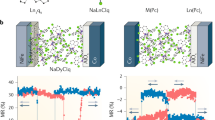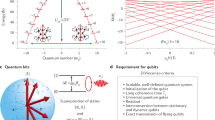Abstract
A revolution in electronics is in view, with the contemporary evolution of the two novel disciplines of spintronics and molecular electronics. A fundamental link between these two fields can be established using molecular magnetic materials and, in particular, single-molecule magnets. Here, we review the first progress in the resulting field, molecular spintronics, which will enable the manipulation of spin and charges in electronic devices containing one or more molecules. We discuss the advantages over more conventional materials, and the potential applications in information storage and processing. We also outline current challenges in the field, and propose convenient schemes to overcome them.
This is a preview of subscription content, access via your institution
Access options
Subscribe to this journal
Receive 12 print issues and online access
$259.00 per year
only $21.58 per issue
Buy this article
- Purchase on Springer Link
- Instant access to full article PDF
Prices may be subject to local taxes which are calculated during checkout




Similar content being viewed by others
References
Wolf, S. A. et al. Spintronics: a spin-based electronics vision for the future. Science 294, 1488–1495 (2001).
Awshalom, D. D. & Flatté, M. M. Challenges for semiconductor spintronics. Nature Phys. 3, 153–159 (2007).
Dery, H., Dalal, P., Cywiński, Ł. & Sham, L. J. Spin-based logic in semiconductors for reconfigurable large-scale circuits. Nature 447, 573–576 (2007).
Xiong, Z. H., Wu, D., Valy Vardeny, Z. & Shi, J. Giant magnetoresistance in organic spin-valves. Nature 427, 821–824 (2004).
Ratner, M. A. (ed.) Special feature on molecular electronics. Proc. Natl Acad. Sci. 102, 8800–8837 (2005).
Tao, N. J. Electron transport in molecular junctions. Nature Nanotech. 1, 173–181 (2006).
Sanvito, S. & Rocha, A. R. Molecular spintronics: The art of driving spin through molecules. J. Comput. Theor. Nanosci. 3, 624–642 (2006).
Christou, G., Gatteschi, D., Hendrickson, D. N. & Sessoli, R. Mater. Res. Soc. Bull. 25, 66–71 (2000).
Gatteschi, D., Sessoli, R. & Villain, J. Molecular Nanomagnets (Oxford Univ. Press, New York, 2007).
Carretta, S. et al. Quantum oscillations of the total spin in a heterometallic antiferromagnetic ring: Evidence from neutron spectroscopy. Phys. Rev. Lett. 98, 167401 (2007).
Ardavan, A. et al. Will spin-relaxation times in molecular magnets permit quantum information processing? Phys. Rev. Lett. 98, 057201 (2007).
Leuenberger, M. N. & Loss, D. Quantum computing in molecular magnets. Nature 410, 789–793 (2001).
Troiani, F. et al. Molecular engineering of antiferromagnetic rings for quantum computation. Phys. Rev. Lett. 94, 207208 (2005).
Lehmann, J., Gaita-Ariño, A., Coronado, E. & Loss, D. Spin qubits with electrically gated polyoxometalate molecules. Nature Nanotech. 2, 312–317 (2007).
Friedman, J. R., Sarachik, M. P., Tejada, J. & Ziolo, R. Macroscopic measurement of resonant magnetization tunneling in high-spin molecules. Phys. Rev. Lett. 76, 3830 (1996).
Thomas, L. et al. Macroscopic quantum tunnelling of magnetization in a single crystal of nanomagnets. Nature 383, 145–147 (1996).
Wernsdorfer, W. & Sessoli, R. Quantum phase interference and parity effects in magnetic molecular clusters. Science 284, 133–135 (1999).
Heersche, H. B. et al. Electron transport through single Mn12 molecular magnets. Phys. Rev. Lett. 96, 206801 (2006).
Jo, M.-H. et al. Signatures of molecular magnetism in single-molecule transport spectroscopy. Nano. Lett. 6, 2014–2020 (2006).
Cornia, A. et al. Preparation of novel materials using SMMs. Struct. Bond. 122, 133–161 (2006).
Fleury, B. et al. a new approach to grafting a monolayer of oriented Mn12 nanomagnets on silicon. Chem. Comm. 2020–2022 (2005).
Naitabdi, A., Bucher, J.-P., Gerbier, Ph., Rabu, P. & Drillon, M. Self-assembly and magnetism of Mn12 nanomagnets on native and functionalized gold surfaces. Adv. Mater. 17, 1612–1616 (2005).
Coronado, E. et al. Polycationic Mn12 single-molecule magnets as electron reservoirs with S>10 ground states. Angew. Chem. Int. Ed. 43, 6152–6156 (2004).
Bogani, L. et al. Magneto-optical investigations of nanostructured materials based on single-molecule magnets monitor strong environmental effects. Adv. Mater. 19, 3906–3911 (2007).
Ishikawa, N., Sugita, M., Ishikawa, T., Koshihara, S. & Kaizu, Y. Mononuclear lanthanide complexes with a long magnetization relaxation time at high temperatures: A new category of magnets at the single-molecular level. J. Phys. Chem. B 108, 11265–11271 (2004).
Wahl, P. et al. Exchange interaction between single magnetic adatoms. Phys. Rev. Lett. 98, 056601 (2007).
Hirjibehedin, C. F. et al. Large magnetic anisotropy of a single atomic spin embedded in a surface molecular network. Science 317, 1199–1202 (2007).
Kim, G.-H. & Kim, T.-S. Electronic transport in single molecule magnets on metallic surfaces. Phys Rev. Lett. 92, 137203 (2004).
Park, H., Kim, A. K. L., Alivisatos, A. P., Park J. & McEuen, P. L. Fabrication of metallic electrodes with nanometer separation by electromigration. Appl. Phys. Lett. 75, 301–303 (1999).
Hanson, R., Kouwenhoven, L. P., Petta, J. R., Tarucha S. & Vandersypen L. M. K. Spins in few-electron quantum dots. Rev. Mod. Phys. 79, 1217–1265 (2007).
Kouwenhoven, L. P. et al. in Mesoscopic Electron Transport (eds Sohn, L. L., Kouwenhoven, L. P. & Schön, G.) 105–214 (Series E 345, Kluwer, 1997).
Chakov, N. E., Soler, M., Wernsdorfer, W., Asbboud, K. A. & Christou, G. Single-molecule magnets: Structural characterization, magnetic properties, and 19F NMR spectroscopy of a Mn12 family spanning three oxidation levels. Inorg. Chem. 44, 5304–5321 (2005).
Romeike, C., Wegewijs, M. R. & Schoeller, H. Spin quantum tunneling in single molecule magnets: Fingerprints in transport spectroscopy of current and noise. Phys. Rev. Lett. 96, 196805 (2006).
Romeike, C. et al. Charge-switchable molecular nanomagnet and spin-blockade tunneling. Phys Rev. B 75, 064404 (2007).
Erste, F. & Timm, C. Cotunneling and nonequilibrium magnetization in magnetic molecular monolayers. Phys Rev. B 75, 195341 (2007).
Timm, C. Tunneling through magnetic molecules with arbitrary angle between easy axis and magnetic field. Phys. Rev. B 76, 014421 (2007).
Goldhaber-Gordon, D. et al. Kondo effect in a single-electron transistor. Nature 391, 156–159 (1998).
Cronenwett, S. M., Oosterkamp, T. H. & Kouwenhoven, L. P. A tunable Kondo effect in quantum dots. Science 281, 540–544 (1998).
van der Wiel, W. G. et al. The Kondo effect in the unitary limit. Science 289, 2105–2108 (2000).
Nygard, J., Cobden, D. H. & Lindelof, P. E. Kondo physics in carbon nanotubes. Nature 408, 342–346 (2000).
Park, J. et al. Coulomb blockade and the Kondo effect in single-atom transistors. Nature 417, 722–725 (2002).
Liang, W., Shores, M. P., Bockrath, M. & Long, J. R. Kondo resonance in a single-molecule transistor. Nature 417, 725–729 (2002).
Aromì, G. & Brechin, E. K. Synthesis of 3d metallic single-molecule magnets. Struct. Bond. 122, 1–67 (2006).
Romeike, C., Wegewijs, M. R., Hofstetter W. & Schoeller, H. Kondo-transport spectroscopy of single molecule magnets. Phys. Rev. Lett. 97, 206601 (2006).
Romeike, C., Wegewijs, M. R., Hofstetter, W. & Schoeller, H. Quantum-tunneling-induced kondo effect in single molecular magnets. Phys. Rev. Lett. 96, 196601 (2006).
Leuenberger, M. N. & Mucciolo, E. R. Berry-phase oscillations of the Kondo effect in single-molecule magnets. Phys. Rev. Lett. 97, 126601 (2006).
Waldron, D., Haney, P., Larade, B., MacDonald, A. & Guo, H. Nonlinear spin current and magnetoresistance of molecular tunnel junctions. Phys. Rev. Lett. 96, 166804 (2006).
Rocha, A. R. et al. Towards molecular spintronics. Nature Mater. 4, 335–339 (2005).
Pasupathy, A. N. et al. The Kondo effect in the presence of ferromagnetism. Science 306, 86–89 (2004).
Hueso L. E. et al. Transformation of spin information into large electrical signals using carbon nanotubes. Nature 445, 410–413 (2007).
Liu, R., Ke, S.-H., Baranger, H. U. & Yang, W. Negative differential resistance and hysteresis through an organometallic molecule from molecular-level crossing. J. Am. Chem. Soc. 128, 6274–6275 (2006).
Timm, C. & Elste, F. Spin amplification, reading, and writing in transport through anisotropic magnetic molecules. Phys. Rev. B 73, 235304 (2006).
Elste, F. & Timm, C. Transport through anisotropic magnetic molecules with partially ferromagnetic leads: Spin-charge conversion and negative differential conductance. Phys. Rev. B 73, 235305 (2006).
Misiorny, M. & Barnaś, J. Magnetic switching of a single molecular magnet due to spin-polarized current. Phys. Rev. B 75, 134425 (2007).
van der Wiel, W. G. et al. Electron transport through double quantum dots. Rev. Mod. Phys. 75, 1–22 (2003).
Wernsdorfer, W., Aliaga-Alcalde, N., Hendrickson, D. N. & Christou G. Exchange-biased quantum tunneling in a supramolecular dimer of single-molecule magnets. Nature 416, 406–409 (2002).
Affronte, M. et al. Linking rings through diamines and clusters: Exploring synthetic methods for making magnetic quantum gates. Angew. Chem. Int. Ed. 44, 6496–6490 (2005).
Ouyang, M. & Awshalom, D. Coherent Spin-transfer between molecularly bridged quantum dots. Science 301, 1074–1076 (2003).
Merrifield, B. Solid Phase Synthesis Available at <http://nobelprize.org/nobel_prizes/chemistry/laureates/1984/merrifield- lecture.html>.
Cleuziou, J.-P., Wernsdorfer, W., Bouchiat, V., Ondarçuhu, T. & Monthioux, M. Carbon nanotube superconducting quantum interference device. Nature Nanotech. 1, 53–59 (2006).
Shimada, H., Ono, K & Otuka, Y. Driving the single-electron device with a magnetic field. J. Appl. Phys. 93, 8259–8264 (2003).
Green, J. E. et al. A 160-kilobit molecular electronic memory patterned at 1011 bits per square centimeter. Nature 445, 414–418 (2007).
Ishikawa, N., Sugita, M. & Wernsdorfer, W. Quantum tunneling of magnetization in lanthanide single-molecule magnets: Bis(phthalocyaninato)terbium and bis(phthalocyaninato)dysprosium anions. Angew. Chem. Int. Ed. 44, 2931–2935 (2005).
Kasumov, A. et al. Proximity effect in a superconductor-metallofullerene-superconductor molecular junction. Phys. Rev. B 72, 033414 (2005).
Wernsdorfer, W., Murugesu, M. & Christou, G. Resonant tunneling in truly axial symmetry Mn12 single-molecule magnets: Sharp crossover between thermally assisted and pure quantum tunneling. Phys. Rev. Lett. 96, 057208 (2006).
Acknowledgements
This work is partially financed by ANR-PNANO, Contract MolSpintronics No. ANR-06-NANO-27 and by EC-RTN QUEMOLNA Contract No. MRTN-CT-2003-504880. L.B. acknowledges E.U. support through the EIF-041565-'MoST' Marie Curie fellowship.
Author information
Authors and Affiliations
Rights and permissions
About this article
Cite this article
Bogani, L., Wernsdorfer, W. Molecular spintronics using single-molecule magnets. Nature Mater 7, 179–186 (2008). https://doi.org/10.1038/nmat2133
Issue Date:
DOI: https://doi.org/10.1038/nmat2133
This article is cited by
-
Vibrational properties of a mononuclear dysprosium containing singlemolecule magnet
Interactions (2024)
-
A spin–rotation mechanism of Einstein–de Haas effect based on a ferromagnetic disk
Frontiers of Physics (2024)
-
Electrical detection and modulation of magnetism in a Dy-based ferroelectric single-molecule magnet
Nature Communications (2023)
-
A hard molecular nanomagnet from confined paramagnetic 3d-4f spins inside a fullerene cage
Nature Communications (2023)
-
Local cation-tuned reversible single-molecule switch in electric double layer
Nature Communications (2023)



